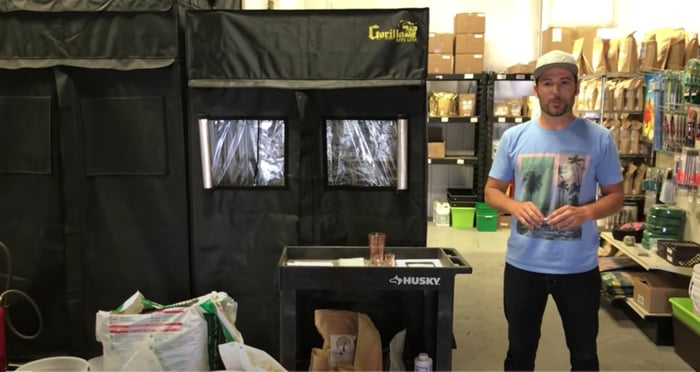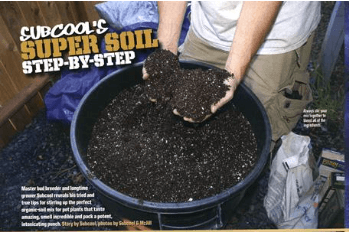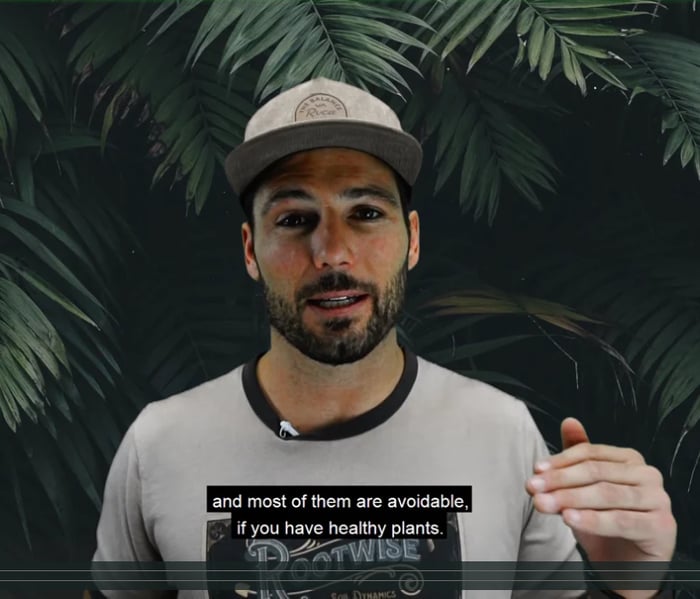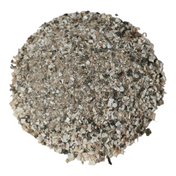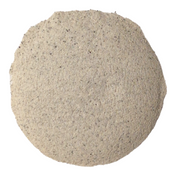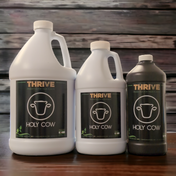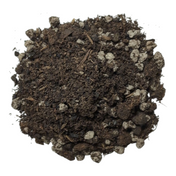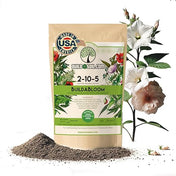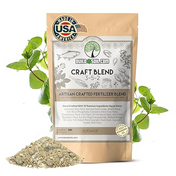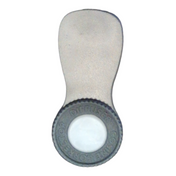How do I water Living Soil?
This is the 20% that causes 80% of the issues. Learn to water and success is much closer.
Here is the fast rule of thumb to consider.
5-10% of the soil volume for potting soils.
Small Containers with bigger plants need daily water. here's how to measure the amount of water per gallon of soil.
How to water living soil
Big Containers with Smaller plants need water once a week or so. The idea is to maintain optimal moisture. When I have multiple plants in one large container and cover crop going I can water every day to every other day in small amounts. But the same grower at home with less plants per bed might be able to go a week. Use these guidelines to come up with your own routine.
So how much water is 5% or 10%?
Use your soil volume to multiply by 5% or 10%
For example: 30 Gallons of soil = (30 gallons of soil x 5% = 1.5 gallons of water)
The next thing to remember is that it’s all relative to VPD, plant size vs. container size, and speed of growth.
VPD = Vapor Pressure Deficit and is the key to balancing proper temperatures with consideration to the humidity. Blog Post on VPD: https://buildasoil.com/blogs/news/vapor-pressure-deficit-vpd-guide-from-pulse-one-grow-room-monitor
For instance. You have 10 gallon soil containers. You’ll probably water half of a gallon per watering and you could even use a little less if you do this daily or the plant is not large yet. But if you live somewhere where it is humid and your grow room is not warm, your plants will not be growing under ideal circumstances which means they just won’t be able to drink as much water as needed. That being said you would then need to factor that into your watering equation.
Now on the other hand if you have a larger plant and it’s dry and warm you’ll probably be watering closer to 1 full gallon of water per each watering and still maybe everyday.
Think of soil moisture on a scale of 1-10. 1 being bone dry and 10 being muddy wet. We want to operate in the 3-7 range all day long, day in and day out. You can do this by calibrating automatic watering systems or by hand watering with a little intelligent thought.
Watering the soil to make sure the plants are happy is the number one challenge most new no-till growers will face. Without a carnal understanding of what the plants and soil require, the newer grower will spent countless hours chasing their tail. If you know your soil has plenty of nutrients but it just isn’t growing properly it all comes back to watering habits.
Not only will the plant miss out on key nutrients because of this but it’s decline in overall health will literally send the signal to natures clean up crew to come and get rid of your plants. Now, of course it’s not all that simple, but for the most part the bugs and pests we have come to dislike actually do serve a purpose. The problem is that people are unknowingly causing their own pest and disease issues because of over and or under-watering their soil and plants.
Think of the plant as an intelligent being that has no control over it’s environment and only control over how it reacts. Our goal is to give the plants the environment that will lead to the most efficient use of water and the fastest growth. To get good use of water we need warmer temps and balanced humidity with good grow lights and good soil.
So let’s make sure you have a mental process to walk through and maybe you can see your own answer…
Temps? High and Low? Low temps can cause overwatering, high temps can cause underwatering…
Humidity? High and Low? Low humidity will cause plant growth issues but also will require more waterings. High humidity is ideal in veg and can speed up growth but is easier to over water.
Rootzone Temperature? Cold temps will drastically slow growth and slow the water use.
Canopy Temperature? High Canopy temps can drive moisture movement by drying the plant out so it has to constantly move moisture to the top of the plant and this can drive plant growth to a certain point. Low Canopy temps can be good for flowering but not as good for veg so just consider your canopy temperature when dialing your VPD. Consider using a laser to test the top leaves near the grow light. Low Canopy temps can lead to over-watering easier.
When do you water normally? Do you have a routine? Best practices are to water when the lights turn on or in the morning and at a consistent time. If you are have no routine and water whenever you feel like it you will have a garden with weak plants and pests and disease. Just sticking to a routine can eliminate many issues. It only becomes a problem when the routine leads to over-watering instead of paying attention to the plants and soils needs.
Do you water too fast? We recommend using a pump sprayer for smaller gardens so you can water slow and even like rain and not fast and rushed like a tsunami.
When was the last time you watered and how much? Was if more than 5-10% by volume? Was is very recent? You probably aren’t under-watered but if the watering before that was a long time out and things got dry in between your soil could have gone hydrophobic and have dry spots. That is why consistency is so helpful.
How often are you watering? We prefer to see less water and more often. The best drip systems are watering several times per day in small amounts. Most growers that we know that hand water usually water everyday or every other day depending on container size, plant size etc.
What size grow container? Large container with small plant error on the side of less water. Large plant and small container error on the side of too much water.
How many plants per container? Consider how much soil is really there per plant. If you have 3 plants in a 15 gallon container your watering needs to be more often than if you only had 1 plant.
What PHASE (seedling, vegetative or flower) are the plants in? Seeds need enough water to germinate and then after that make sure they have a little less water as they are easy to over water while young. Then as the plants mature in a small container they will need much more water. The next big phase of water use is when you go into flower for the first 2 weeks during this time the plants will double in size. It’s important to note mentally when this growth phase slows down so you adjust your watering accordingly.
How big are the plants? Again, if you have a larger plant and a smaller container you will be watering much more often sometimes twice per day to keep her happy.
How big are the plants relative to container size? AGAIN! If you have small plant and big container it’s easy to over-water, if you have large plant and small container it’s easy to underwater.
How Heavy Is Your Container? You should lift or tilt your grow container to get an idea of how heavy before and after you water. You can then reference that feeling later when you aren’t sure if over or under-watered.
Thump the side with your hand, does it sound hollow? Or Dense and wet? If it is light and sounds hollow it’s under-watered. If it sounds dense and wet you are probably not under-watered.
What is the age of your plants? Have they grown root-bound and are just too old? Maybe there are multiple issues at play? Consider the age and health of plants along with the size and you’ll be thinking smart.
How long have they been in the soil mixture they are in now? Could it be the new soil? Or maybe they have been in it too long and depleted nutrients? Maybe it’s not your watering! Be sure to consider a living soil if it's time to make a change. Build A Soil, your own soil, for the best results.
Were they in the same mixture when they were seedlings/smaller plant? Sometimes changing recipes can cause some strange issues until the plants get used to the new soil.
What substrate/medium are you using? Do you have enough aeration? Or way too much? Sometimes considering what your soil recipe is will clue you into the understanding of over or under-watered.
What type of grow light? Do you have enough power? Too much? Plants like a certain amount of light in veg and flower and many new growers will take short cuts and get a cheaper grow light that will slow plant growth and cause over-watering. On the other hand if you have a powerful new grow light maybe it’s too much in the beginning? Make sure the plants are happy and the environment is good and you’ll be way ahead of the issues because there will be a wider margin for error.
What is the distance to the canopy? Grow lights need to be at the proper distance to work. Make sure you take this into consideration.
What is your relative humidity? To low and you’ll underwater while slowing growth of the plants. Too high of humidity and you’ll over-water more than likely.
What is the canopy temperature? Laser the leaf and find out! Adjust your watering of the plant and soil accordingly.
What is the Day/Night Temp? (Include fluctuation range) Big swings in temps can cause issues. Low temps can cause over-watering and high temps under-watering. Factor this into you routine.
Tell us about your ventilation, intake exhaust and when its running and not running ? If your have no air circulation or venting you can have more issues like C02 and or weak plants. Ideally we want to mimic nature and have plenty of fresh air (Exhaust and Intake) and plenty of air circulation (Oscillating fans)
Is the fan blowing directly at plants? You’ll notice if the plant blows directly at one plant it will look weak and have issues compared to the others. You want to have a balanced environment.
Finally, are plant's infected with pest's? (Are you sure?) Did you scope to make sure?

